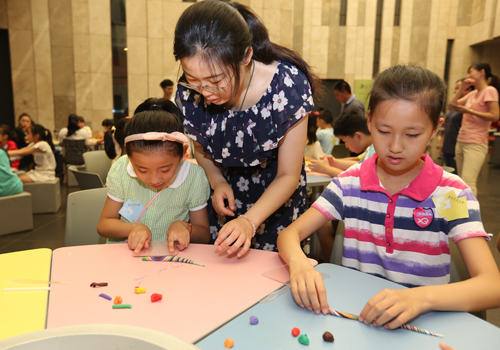Collaboration between galleries, universities can boost education

Pupils learn to make dough figurines at the Jiangsu Art Museum, which is a public education activity during their summer holidays.
Galleries around China have made use of the summer period to hold a series of diverse events to boost engagement with the public. While larger facilities have a bigger cultural footprint and thus find it easier to draw crowds, smaller local galleries have focused on their own specific strengths and characteristics to lure in visitors.
Gallery-school collaboration
An increasing number of galleries have begun to cooperate with middle and primary schools to promote public education in recent years. Efficient use of resources on the part of galleries, along with student-friendly atmospheres, have both aided in boosting arts education in schools.
The National Art Museum of China has been a pioneer in this form of collaboration. Its collection has been useful in cultivating the historical awareness of students, as well as their appreciation of art. The museum has also emphasised correct etiquette for visiting galleries and museums.
The Zhejiang Art Museum launched a program named Art Classroom in 2014. Museum staff go to rural areas to decorate art classrooms with different themes. At the same time, they bring new art curriculums and books to less developed areas.
“Galleries’ involvement in public education should become an effective method to allow young people to access cultural traditions and artistic development as a substitute for classroom education. Galleries and schools need to develop a long-term relationship so that the two sides can promote artistic education together,” said Wu Wenxiong, dean of the Changshu Art Museum in Jiangsu Province.
Gallery staff should focus on communication with teachers and parents, stimulating and developing student interest in arts. In addition, they need to pay attention to studies on adolescent education and psychology, Wu added.
Small galleries’ exploration
At present, galleries in small and medium-sized cities have disadvantages when it comes to human and teacher resources, publicity as well as operations. They need to learn from their counterparts in promoting public education, but there is huge potential as well.
Galleries should make and implement public education plans after taking into account the situation on the ground in each area, which requires in-depth research on aspects such as target groups and features of public education methods. Only in this way can galleries find solutions for sustainable development, Wu said.
A great number of gallery representatives suggest easing the shortage of teachers in public education through collaboration with universities. “The Wuhan Art Museum is developing close relations with local universities so that they can be complementary in use of resources. Galleries require talent to hold public education events but it is not practical for galleries to train professional teachers by themselves. Through strategic collaboration, galleries can ease the lack of talent to a great extent,” said Lan Tian, a faculty member from the Wuhan Art Museum. At the same time, galleries can provide universities opportunities to exhibit and practice, thus achieving a mutually beneficial situation. For example, the Guilin Art Museum signed contracts with three local universities, allowing museum staff to practice art training for adults in mountainous regions and less-developed areas. They also hold regular lectures within and outside the gallery.
Big cities have abundant art resources, a large number of educational organs and significant professional talent. Galleries in big cities can pioneer efforts to give lectures and hold exhibitions at the grassroots level in order to alleviate the resource shortages of local galleries. At the same time, local galleries can hold activities to provide lectures for the public, thus attracting more people to visit galleries, said Jin Tian, deputy dean of the Jiangsu Art Museum.
The progress in public education depends on sufficient excellent resources and exhibitions. Increased influence leads to more public attention, which is the bedrock of sustainable and healthy development of public education, Jin added.
